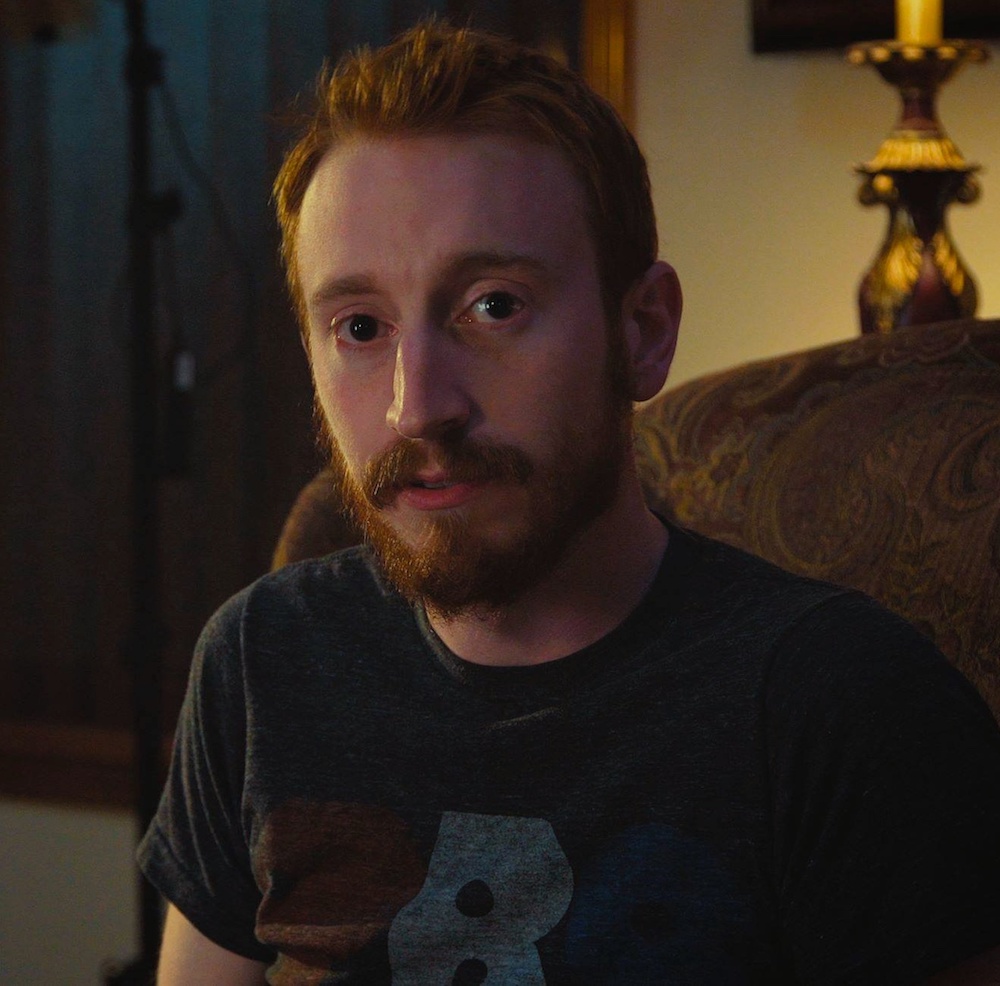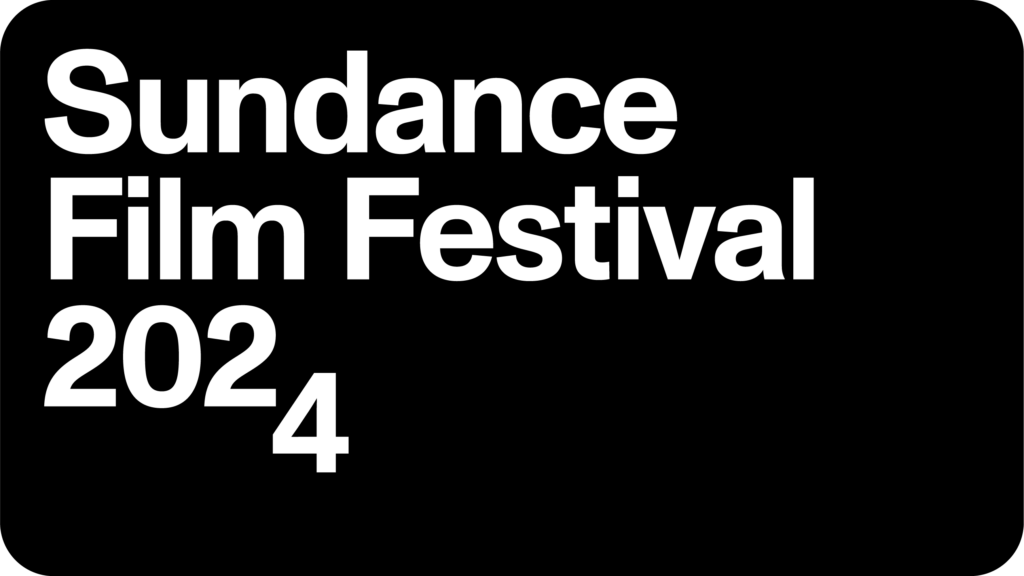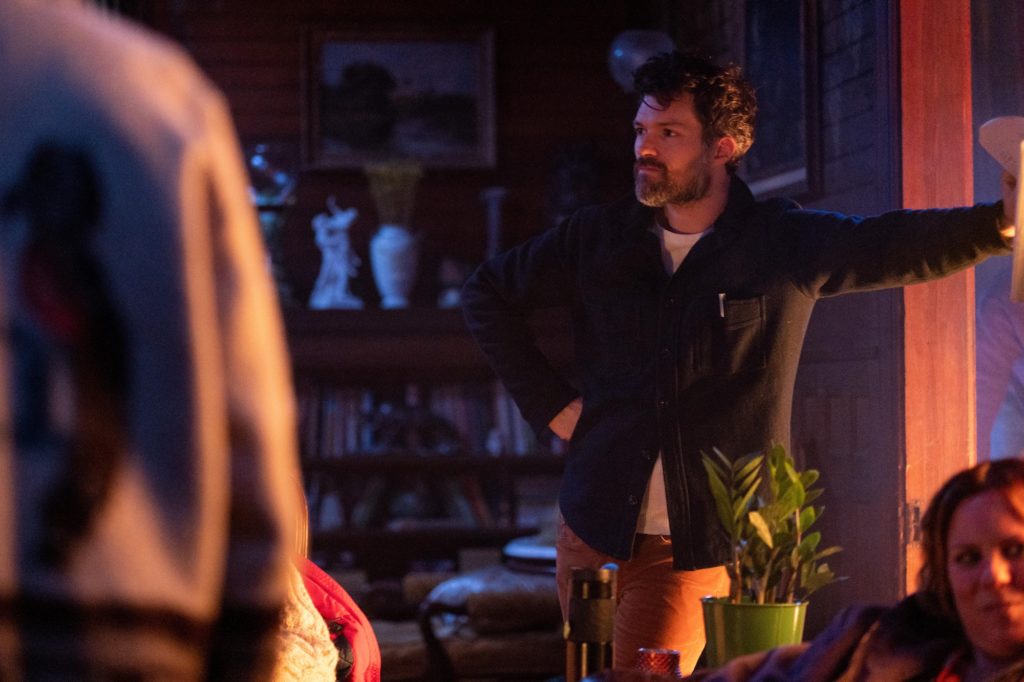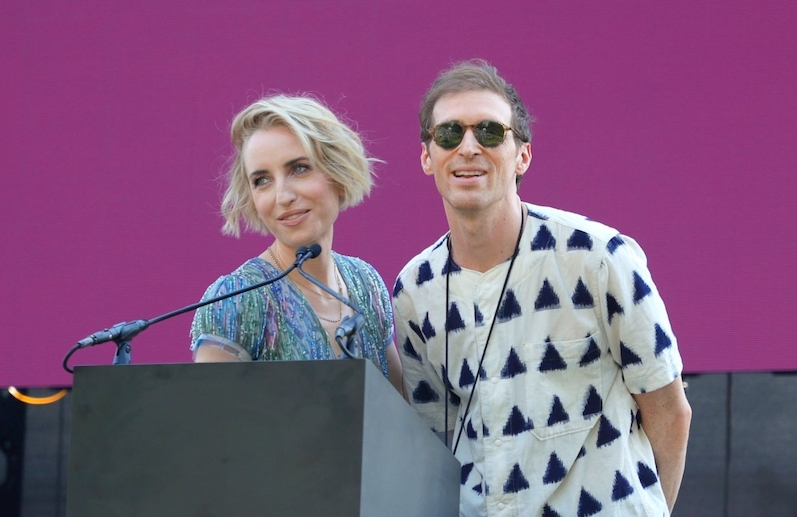Like many indie filmmakers, FRANKLIN RITCH made a proof-of-concept to help sell his vision of a potential feature debut. Unlike a lot of other proofs-of-concept like sizzle reels or trailers, the scene Ritch shot made it into the final product; in fact, it encompasses the entire first third of the movie. But placing so many of his eggs in that first-scene basket paid off for the Florida-based filmmaker. Producers signed on, the remaining two-thirds were filmed (bringing on a veteran actor in the process), and the feature-length sci-fi thriller THE ARTIFICE GIRL was born.
The Artifice Girl begins with Ritch as Gareth, a visual effects artist brought before two special agents (Sinda Nichols and David Girard) with questions about his online activity and the presence of a young girl’s (Tatum Matthews) photos and livestreams on his hard drive. Unfolding over the course of three chapters, not all is as it seems with the girl’s identity and Gareth’s mission. Genre film mainstay Lance Henriksen co-stars in the film, which premiered at the 2022 Fantasia International Film Festival (where it won the Golden Audience Award) and screened at the 2023 South by Southwest Festival before XYZ Films acquired distribution rights. The Artifice Girl will be available in theaters, on demand, and digital on April 27.
We spoke with the film’s screenwriter, director, editor, and star, Franklin Ritch, about how he — slowly but surely — pulled off his debut feature.
——
COLIN McCORMACK: You tackle a lot of themes in The Artifice Girl and between those and the science [aspects], I assume it entailed a lot of research before you could begin. How did you know where to start when it came time to put pen to paper on the script?
FRANKLIN RITCH: I kind of knew going into this that that was going to be the big challenge, making sure there was a certain degree of technical accuracy that the average viewer could buy into. Now that robotics, AI, and machine learning have advanced so much in just the past few years since the script was written, I’m sure there are plenty of holes that an actual programmer could punch into the script. But I just went straight to the source and spoke to a lot of programmers and people developing AI programs. I did take an online course and tried to understand the basics of machine learning, but I am not a tech-savvy person by any means. I really was looking at the technical aspect as a conduit to explore the themes of childhood trauma and autonomy. But it was really great talking to professionals and specialists and people who did that sort of thing for a living; I got a lot of insight from conversations with those people.
CM: In terms of the form of the film, did you look at that first section as its own entity or was it always Chapter One of a full-length feature?
FR: It was always going to be three acts from the get-go. Initially, the idea of the development of an AI program that would hunt down predators seemed like a large-scale, globe-trotting cinematic experience, and for that reason, I shelved the idea for a few weeks. It wasn’t until I re-approached it as a one-location, three-character sequence that I said, “Okay, this could be interesting if we started this story here,” and the audience was caught up to speed along with the people that worked for the NGO. From there, it was, I want to see what happens 50 years from now. So in my mind, it was always going to be a large time-jump film. That helped me with the writing process when approaching that first act, knowing where the story was going to go. That helped a lot to plant these seeds and all the setups that needed to be paid off later.
CM: For production, that first act was filmed and completed before the other two?
FR: Correct, yes. Because we were first-time filmmakers who had never done a feature before, we decided to shoot the entire first act as a proof-of-concept, essentially. Some people shoot a scene or a couple of shots, but we said we really wanted to make this a no-brainer decision for a producer, so we shot and edited and color-corrected and sound-mixed the entire first act on our own with practically no real budget. Then we used that as a way to get funding for the rest of the film. We shot Act Two six months after that and then Act Three six months after that. So there were some pretty substantial gaps between production, which I think in a way helps you feel like there’s a passage of time because we’ve all grown as people throughout that process. That’s how we did that.
CM: How did you decide where to send that proof-of-concept when it was finished? Did you have producers or companies in mind, or just casting a wide net?
FR: Honestly, I really hadn’t had much of a connection to the industry aside from having a short film called Bedridden that had played at Fantastic Fest in Austin, Texas, which is one of my all-time favorite festivals. Through that, I was in touch with the man who became our executive producer, Peter Kuplowsky, and I sent it to him. He was really my only contact as far as the industry was concerned, so I sent it to him and said, “Hey, what do you think? Would you help us get in touch with someone who might be interested in this?” And he was like, “I’m going to stick with you guys. This is something that needs to be seen and I’m going to make sure this gets in front of the right people.” He got us in touch with Paper Street Pictures, who became our production company partners on the project.
CM: In terms of your team and your crew and cast in making the initial proof-of-concept, were they the people you collaborated with on your shorts?
FR: Yeah, everybody that I worked with was someone I had already worked with for several years on short films. Tatum Matthews, who plays Cherry, I had cast her in a local theatre project I was directing. It was a production of Wait Until Dark, which you probably know the Audrey Hepburn/Alan Arkin film adaptation. She had auditioned for the child role and her audition had us in tears. It was like, “Okay, you got the part,” but in the back of my mind I’m [thinking], If I ever need a child actor, this kid is amazing. Sure enough, the character of Cherry was so in line with Tatum’s strengths. So I have worked with her on several other projects since then. Same thing with David Girard, who plays Amos, I had worked with him on pretty much everything for the past several years. And Sinda Nichols I had been very close to and worked with on several theatre productions. Everyone was kind of a close-knit family at that point, we’d all worked together on stuff. And of course, my director of photography Britt McTammany — without whom this film would look terrible because he’s an incredible cinematographer — he and I have been working together for ten-plus years. That relationship and closeness contributed greatly to the film.
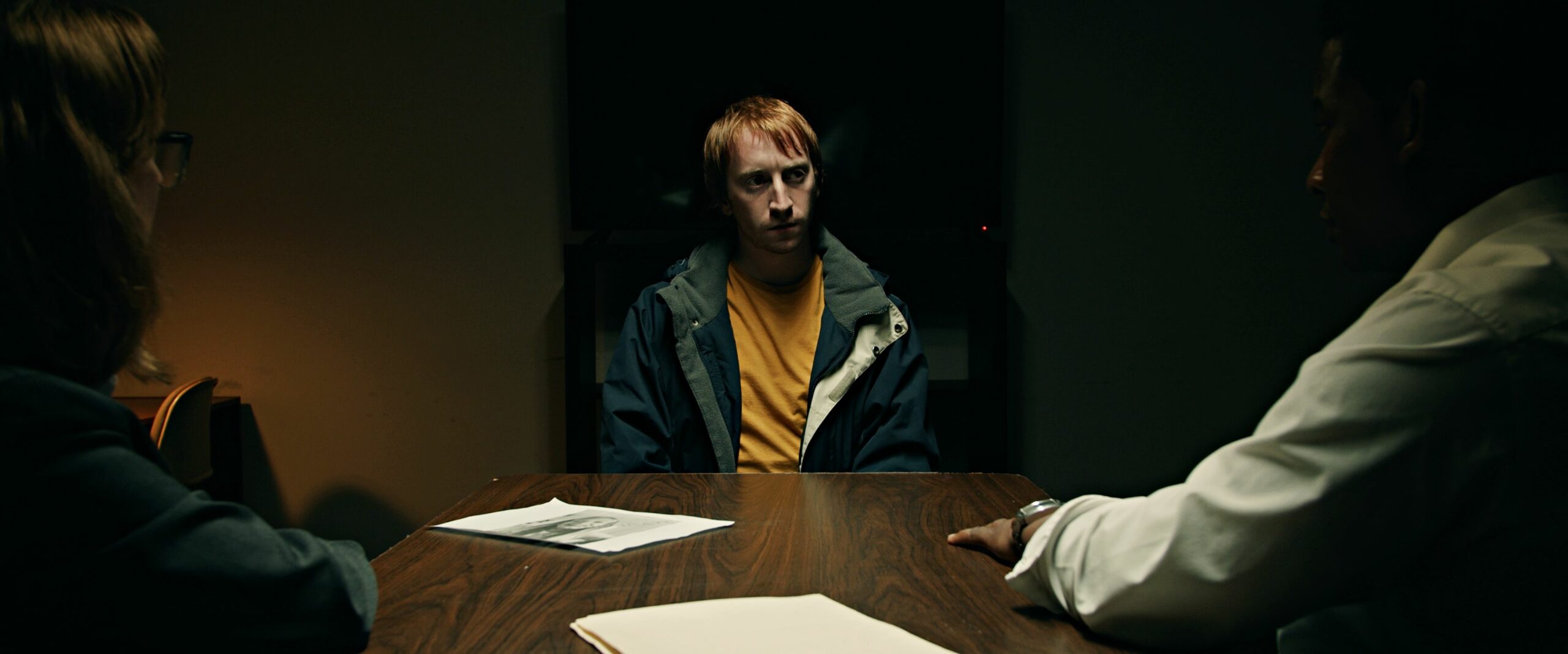
CM: Working with Britt, do you have any tips on how you made such limited locations visually dynamic?
FR: Pre-production was a huge part of it. We had extensive shot lists. I went into the film knowing that I was going to be editing it and approached it with a minimalist amount of coverage, which made the coverage more deliberate. So I knew moment-to-moment, beat-to-beat, how I wanted it visually presented. You’re right, when you’ve got three characters in an empty room, it’s hard to keep that dynamic and interesting for 40 minutes, so we made sure that visually, every shot was saying something. It means something when a character is talking in a medium shot, it means something else when you cut to a close-up or when you cut to a shot where they’re looking into the camera or a profile. All of that is relevant. The audience may not consciously notice it, but they will subconsciously. It will be important to how they experience the story. We definitely did a lot of pre-production and shot planning to make sure that it felt like the film was kinetic.
CM: In pre-production, were you and the actors given time for rehearsal? It’s a lot of dialogue, but I know on low-budget projects rehearsal is a luxury.
FR: We started the project right at the end of Spring 2020, so everybody had Zoom and that was a huge thing for us. We could just hop on a Zoom call and rehearse for one hour, three times a week, and we loved it. It never felt like we had to go to a rehearsal. Because we all liked each other, it was an opportunity to socialize and we were all socially deprived at that time. So it was great having that consistent rehearsal schedule to let the dialogue be second nature so once we were on set we could just focus on the blocking and the subtleties and nuances of the performances. The rehearsal process was huge and now for every future project, I’ll probably have a lot of Zoom rehearsals because it helped a lot.
CM: Once Lance Henriksen signed on, did your feeling about the film or the weight on your shoulders change in a significant way?
FR: Are you implying that there would be some sort of pressure in working with a legend like Lance Henriksen? No, not at all! We were ready to go! Seriously, Lance was always at the top of our list for that role. We didn’t know that Lance would be involved until after we had shot Act Two. Once Lance was involved and we realized this was real and the dream of having an A-list legend like him was not only possible but was happening, there was a little bit of [feeling like], Oh gosh, are we ready for this? But that feeling was gone the moment Lance was on set. The crew stepped up in an incredible way and they were so precise and meticulous and efficient. There wasn’t a wasted moment of setup. And Tatum was so incredible. To have this young talented actor who I felt I had discovered paired up with this actor I had idolized since I was a kid was a dream come true. Their chemistry was immediate and when we started doing rehearsals you could feel that there was magic happening. The pressure felt like it was there until Lance was there. He was such an incredibly wonderful, genuine, passionate person and he cared so much about the project and about the themes. We had hour-long conversations over the phone frequently talking about the character of Gareth and the story. That alleviated a lot of that pressure because there was that trust that we developed very quickly.
CM: You mentioned earlier that you knew ahead of time that you’d be editing the film. I’m always curious when a person is editing their own performance and what that process and experience are like.
FR: You definitely have to disassociate a little bit and not perceive the character on-screen as yourself but as the character. I felt like I can do that, I can compartmentalize that, I think. Still, I would love to see a professional editor that we could never afford, what their version of the film would look like. I’m sure there would be some interesting changes where I would be like, “Oh yeah, that makes a lot more sense.” [Laughs] Also it was helpful that I didn’t like the character of Gareth, even though I was playing him. I knew from the get-go that this guy was really the antagonist of the story and therefore I never wanted to romanticize or validate him. He clearly thinks he’s the main character of his story, so that played into his portrayal. But I wanted, as the film goes on, for the audience to feel more and more disconnected from him because he’s disconnected from everybody else. That protagonist syndrome hopefully starts to peel away as the film goes on until the end when we realize he’s been the antagonistic force the whole time.
CM: What’s next for you now that the film is coming out?
FR: It’s been crazy. Everybody told me, “Your life is going to change when the film comes out.” And I was like, Okay, okay. But it really has been a crazy year that I never could have anticipated. It’s been really wonderful. Everybody wants to talk about The Artifice Girl now that it’s out there, but I’m just excited about the next one. I just want to talk about what’s next and I’m not allowed to now. I wasn’t allowed to talk about Artifice Girl for three years but now that I’m allowed to, it’s like, Who cares? I want to talk about the next one. Just know that it’s going to be exciting. There are plans for features, there are plans for possible series. Whatever it is, I’m just excited to get to work with all the people I’ve been working with on Artifice Girl and marry them with people who have been doing this for years and years. That’s exciting and I’m looking forward to approaching larger-scale projects.
__
Thank you to Franklin for talking with us about THE ARTIFICE GIRL. Learn more by following the film on Facebook, Instagram, or Twitter.
If you’re an independent filmmaker or know of an independent film-related topic we should write about, email blogadmin@sagindie.org for consideration.

